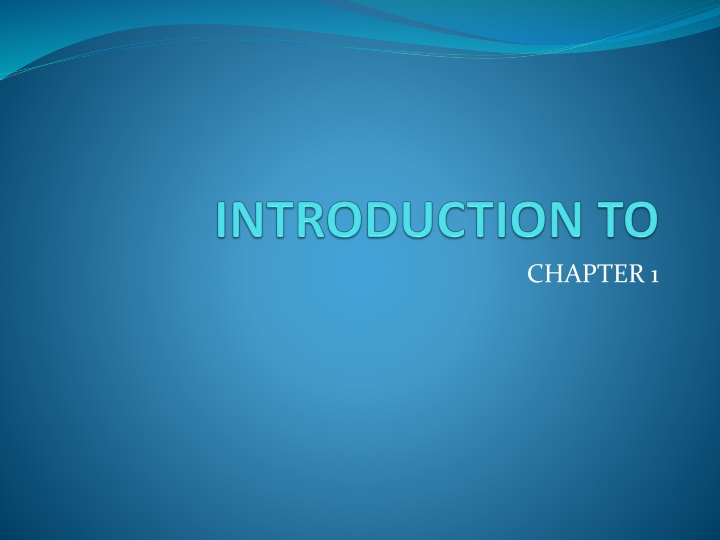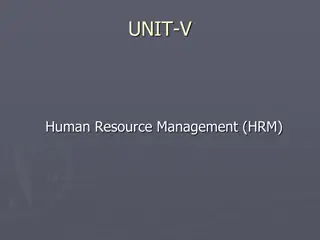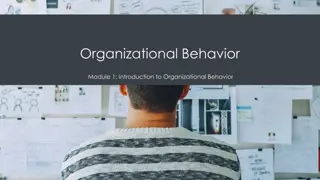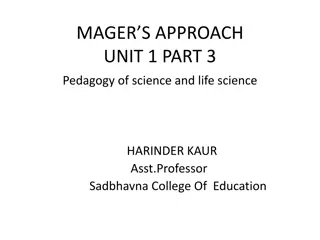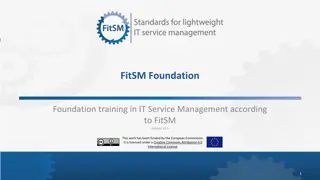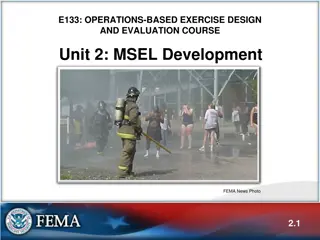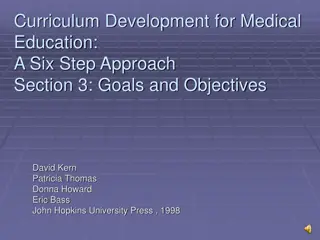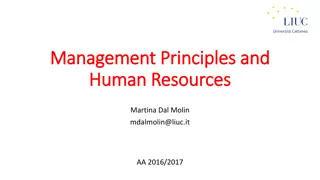Management Concepts and Objectives
In this course, students will delve into the essential concepts and objectives of management, covering topics such as understanding management principles, characteristics, and functions. The course duration spans 4 months with a total of 48 credit hours, emphasizing the importance of efficiency and effectiveness in achieving organizational goals. Lecturer evaluation criteria and class regulations are also outlined to ensure a conducive learning environment. Join to explore the dynamic field of management and enhance your strategic decision-making skills.
Download Presentation

Please find below an Image/Link to download the presentation.
The content on the website is provided AS IS for your information and personal use only. It may not be sold, licensed, or shared on other websites without obtaining consent from the author.If you encounter any issues during the download, it is possible that the publisher has removed the file from their server.
You are allowed to download the files provided on this website for personal or commercial use, subject to the condition that they are used lawfully. All files are the property of their respective owners.
The content on the website is provided AS IS for your information and personal use only. It may not be sold, licensed, or shared on other websites without obtaining consent from the author.
E N D
Presentation Transcript
11-2 Lecturer: Mr. Mohamed Mohamud Osman(Lambo) MBA. Accoung & Finance. Pakistan BBA , Marketing And Finance . pakistan Year: 2019/2020
Course Duration: This course assigned to study with 4 months consecutive relatively 16 weeks through Three Hours per week. Total required credit hours is 48 hours which means 3 hour s per week. Every Two Class at Sunday and One class at saturaday at Morning shift,12 hours per month, 48 hours for all the semester. Examination week is not included the above mentioned time schedule.
Lecturer Evaluation: o Quizzes and assignments 20% o presentation and class participation : 20% o Midterm exam : 20% o Final examination: 40% o Total marks: 100%
Rules and regulations: o No late coming will be accepted. o Please turn off your cell phone or Put on silent Mode during the class. o Deficiency in attendance may lead termination. o Quizzes are unannounced. o Rise your hand when you need to talk o Not allowed unnecessary Movements
Objectives of the chapter Understanding management concepts Characteristics of management Functions of management
Management Defined Management The process of getting things done, effectively and efficiently, through and with other people Efficiency Means doing the thing correctly; refers to the relationship between inputs and outputs; seeks to minimize resource costs Effectiveness Means doing the right things; goal attainment 1 7
MANAGEMENT Management is the attainment of organizational goals in an effective and efficient manner through planning, organizing, staffing, directing and controlling organizational resources. Organizational resources include men(human beings), money, machines and materials.
Definitions Louis E Boone & David L Kurtz- The use of people and other resources to accomplish objectives. Mary Parker Follet- the act of getting things done through people. Frederick Taylor defines Management as the art of knowing what you want to do in the best and cheapest way.
Characteristics Management is a distinct process. Management is an organized activity Management aims at the accomplishment of predetermined objectives. Management is both a science and an art. Management is a group activity Management principles are universal in nature Management integrates human and other resources.
LEVELS OF MANAGEMENT Top Level Middle level Low level
LEVELS OF MANAGEMENT First-line/Low level managers Low level is also known as supervisory/Operative level of management. Supervisors responsible for directing the day-to-day activities of operative employees Middle managers The Branch managers and departmental managers constitute middle level. Individuals at levels of management between the first-line manager and top management Top managers Consist of Board of Directors, Chief Executive or Managing Directors. Top management is the ultimate source of authority and it manages goals and policies for Organizations. Individuals who are responsible for making decisions about the direction of the organization and establishing policies that affect all organizational members 1 12
Functions Of Management PLANNING ORGANIZING CONTROLLING STAFFING DIRECTING
ROLES OF MANAGER Interpersonal: Figurehead Leader Liaison Informational Monitor Disseminator Spokesperson Decisional Entrepreneur Negotiator Resource Allocator Disturbance handler
EVOLUTION OF MANAGEMENT THOUGHT The practice of management is as old as human civilization. The different approaches of management are a) Classical approach, b) Behavioural approach, c) Quantitative approach, d) Systems approach, e) Contingency approach.
a) THE CLASSICAL APPROACH: The classical approach is the oldest formal approach of management thought. Its roots pre-date the twentieth century. The classical approach of thought generally concerns ways to manage work and organizations more efficiently. Three areas of study that can be grouped under the classical approach are scientific management, administrative management, and bureaucratic management.
Major branches in the classical approach to management
Classical Management Approaches Four guiding principles of scientific management (Frederick Taylor) Develop for every job a science that includes standardized work implements, and proper working conditions. Carefully select workers with the right abilities for the job. Carefully train workers to do the job and give them the proper incentives to cooperate with the job science. 4. Support workers by carefully planning their work and by smoothing the way as they go about their jobs. 1. 2. 3. 18
Classical Management Approaches Scientific management (the Gilbreths) Motion study Science of reducing a job or task to its basic physical motions Eliminating wasted motions improves performance
Classical Management Approaches Practical lessons from scientific management Make results-based compensation a performance incentive Carefully design jobs with efficient work methods Carefully select workers with the abilities to do these jobs Train workers to perform jobs to the best of their abilities Train supervisors to support workers so they can perform jobs to the best of their abilities
Classical Management Approaches Administrative principles (Henri Fayol) rules/duties of management: Foresight Organization Command Coordination Control to make sure things happen according to plan and to take necessary corrective action to fit diverse efforts together and ensure information is shared and problems solved to lead, select, and evaluate workers to get the best work toward the plan to provide and mobilize resources to implement the plan to complete a plan of action for the future
Classical Management Approaches Administrative principles (Henri Fayol) Scalar chain there should be a clear and unbroken line of communication from the top to the bottom of the organization Unity of command each person should receive orders from only one boss Unity of direction one person should be in charge of all activities with the same performance objective
Classical Management Approaches Bureaucratic organization (Max Weber) Bureaucracy An ideal, intentionally rational, and very efficient form of organization Based on principles of logic, order, and legitimate authority
Classical Management Approaches Characteristics of bureaucratic organizations: Clear division of labor Clear hierarchy of authority Formal rules and procedures Impersonality Careers based on merit 24
Classical Management Approaches Possible disadvantages of bureaucracy: Excessive paperwork or red tape Slowness in handling problems Rigidity in the face of shifting needs Resistance to change Employee apathy
b) THE BEHAVIORAL APPROACH: The behavioural approach of management thought developed, in part, because of perceived weaknesses in the assumptions of the classical approach. The classical approach emphasized efficiency, process, and principles. The behavioural approach focused on trying to understand the factors that affect human behaviour at work. Human Relations. 2. Behavioural Science. 1.
Behavioral Management Approaches Organizations as communities Mary Parker Follett Groups and human cooperation: Groups allow individuals to combine their talents for a greater good Organizations are cooperating communities of managers and workers Manager s job is to help people cooperate and achieve an integration of interests
Behavioral Management Approaches Organizations as communities Forward-looking management insights: Making every employee an owner creates a sense of collective responsibility precursor of employee ownership, profit sharing, and gain-sharing Business problems involve a variety of inter-related factors precursor of systems thinking precursor of managerial ethics and social responsibility Private profits relative to public good
Behavioral Management Approaches Hawthorne studies Initial study examined how economic incentives and physical conditions affected worker output No consistent relationship found Psychological factors influenced results
Behavioral Management Approaches Hawthorne studies (cont.) Social setting and human relations Manipulated physical work conditions to assess impact on output Designed to minimize the psychological factors of previous experiment Mayo and colleagues concluded: New social setting led workers to do good job Good human relations = higher productivity
Behavioral Management Approaches Hawthorne studies (cont.) Employee attitudes and group processes Some things satisfied some workers but not others People restricted output to adhere to group norms
Behavioral Management Approaches Lessons from the Hawthorne Studies: Social and human concerns are keys to productivity Hawthorne effect people who are singled out for special attention perform as expected
Behavioral Management Approaches Maslow s theory of human needs A need is a physiological or psychological deficiency a person feels compelled to satisfy Need levels: Physiological Safety Social Esteem Self-actualization
c) THE QUANTITATIVE APPROACH: The quantitative approach focuses on improving decision making via the application of quantitative techniques. Its roots can be traced back to scientific management. Management Science (Operations Research):- Management science (also called operations research) uses mathematical and statistical approaches to solve management problems.
Production And Operations Management:-This approach focuses on the operation and control of the production process that transforms resources into finished goods and services.
d) SYSTEMS APPROACH: Feed Back Input Process Out Put External Environmen t
e) CONTINGENCY APPROACH: The contingency approach focuses on applying management principles and processes as dictated by the unique characteristics of each situation. It emphasizes that there is no one best way to manage and that it depends on various situational factors, such as the external environment, technology, organizational characteristics, characteristics of the manager, and characteristics of the subordinates.
ORGANIZATION AND ENVIRONMENTAL FACTORS An organization is a group of people intentionally organized to accomplish a common or set of goals. a) Sole Proprietorships b) Partnerships C) Company:
Sole Proprietorships Sole Proprietorship A business that is owned and operated by one person. The enterprise has no existence apart from its owner. To establish a sole proprietorship, a person merely needs to obtain whatever local and state licenses are necessary to begin operations.
Sole Proprietorships (contd) Advantages Disadvantages Ease of formation Unlimited liability Sole ownership of profits Lack of continuity Decision making and control vested in one owner Less available capital Relative difficulty obtaining long-term financing Flexibility Relative freedom from governmental control Relatively limited viewpoint and experience Freedom from corporate business taxes
Partnerships Partnership In a Partnership, two or more people share ownership of a single business. Like proprietorships, the law does not distinguish between the business and its owners. 7
Articles of Partnership Items Name, purpose, domicile Separate debts Duration of agreement Authority (individual partner s authority on business conduct) Character of partners (general or limited, active or silent) Books, records, and method of accounting Contributions by partners (at inception, at later date) Sale of partnership interest Division of profits and losses Arbitration Draws or salaries Settlement of disputes Rights of continuing partner(s) Additions, alterations, or modifications of partnership Death of a partner (dissolution and windup) Required and prohibited acts Release of debts Absence and disability Business expenses (method of handling) Employee management
Partnerships (contd) Advantages Disadvantages Ease of formation Unlimited liability of at least one partner Direct rewards Growth and performance facilitated Relative difficulty obtaining large sums of capital Flexibility Relative freedom from governmental control and regulation Bound by the acts of just one partner Difficulty of disposing of partnership interest Possible tax advantage
Corporations Corporation A corporation, chartered by the state in which it is headquartered, is considered by law to be a unique "entity", separate and apart from those who own it. A corporation can be taxed; it can be sued; it can enter into contractual agreements. As such, a corporation is a separate legal entity apart from the individuals who own it.
Corporations (contd) Advantages Disadvantages Limited liability Activity restrictions Transfer of ownership Lack of representation Unlimited life Regulation Relative ease of securing capital in large amounts Organizing expenses Double taxation Increased ability and expertise
CLASSIFICATION OF ENVIRONMENTAL FACTORS On the basis of the extent of intimacy with the firm, the environmental factors may be classified into different types namely internal and external. Macro-Environment Micro-Environment Internal-Environment
Macro- Environment Micro- Environment Internal Environment Stake holders Political Resources Suppliers Economic Distributers Capabilities Customers Social Competitors Culture Technology Media
TRENDS AND CHALLENGES OF MANAGEMENT IN GLOBAL SCENARIO The management functions are planning and decision making, organizing. leading, and controlling are just as relevant to international managers as to domestic managers. International managers need to have a clear view of where they want their firm to be in the future; they have to organize to implement their plans: they have to motivate those who work lot them; and they have to develop appropriate control mechanisms.
Do the assignment in groups. Instruction : Answer any THREE. In your View what are the difference between the classical Approach, Behavioral approach and Systematic Approach? Is Management - an art or science? Discuss it? List the contributions of Hennary Fayol towards Management? What are the essential skills of Managers? Explain your Answer.
